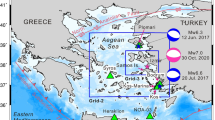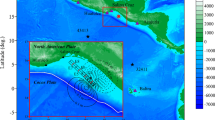Abstract
On September 16, 2015, an earthquake with magnitude of M w 8.3 occurred 46 km offshore from Illapel, Chile, generating a 4.4-m local tsunami measured at Coquimbo. In this study, the characteristics of tsunami are presented by a combination of analysis of observations and numerical simulation based on sources of USGS and NOAA. The records of 16 DART buoys in deep water, ten tidal gauges along coasts of near-field, and ten coastal gauges in the far-field are studied by applying Fourier analyses. The numerical simulation based on nonlinear shallow water equations and nested grids is carried out to provide overall tsunami propagation scenarios, and the results match well with the observations in deep water and but not well in coasts closed to the epicenter. Due to the short distance to the epicenter and the shelf resonance of southern Peru and Chile, the maximum amplitude ranged from 0.1 m to 2 m, except for Coquimbo. In deep water, the maximum amplitude of buoys decayed from 9.8 cm to 0.8 cm, suggesting a centimeter-scale Pacific-wide tsunami, while the governing period was 13–17 min and 32 min. Whereas in the far-field coastal region, the tsunami wave amplified to be around 0.2 m to 0.8 m, mostly as a result of run-up effect and resonance from coast reflection. Although the tsunami was relatively moderate in deep water, it still produced non-negligible tsunami hazards in local region and the coasts of farfield.
Similar content being viewed by others
References
An Chao, Sepúlveda I, Liu P L F. 2014. Tsunami source and its validation of the 2014 Iquique, Chile, earthquake. Geophysical Research Letters, 41(11): 3988–3994
Aránguiz R, González G, González J, et al. 2016. The 16 September 2015 Chile Tsunami from the post-tsunami survey and numerical modeling perspectives. Pure and Applied Geophysics, 173(2): 333–348
Arcos M E M, LeVeque R J. 2015. Validating velocities in the GeoClaw tsunami model using observations near Hawaii from the 2011 Tohoku tsunami. Pure and Applied Geophysics, 172(3–4): 849–867
Catalán P A, Aránguiz R, González G, et al. 2015. The 1 April, 2014 Pisagua tsunami: observations and modeling. Geophysical Research Letters, 42(8): 2918–2925
Contreras-López M, Winckler P, Sepúlveda I, et al. 2016. Field survey of the 2015 Chile Tsunami with emphasis on coastal wetland and conservation areas. Pure and Applied Geophysics, 173(2): 349–367
DeMets C, Gordon R G, Argus D F. 2010. Geologically current plate motions. Geophysical Journal International, 181(1): 1–80
Heidarzadeh M, Satake K. 2013. Waveform and spectral analyses of the 2011 Japan tsunami records on tide gauge and DART stations across the Pacific Ocean. Pure and Applied Geophysics, 170(6–8): 1275–1293
Heidarzadeh M, Murotani S, Satake K, et al. 2016. Source model of the 16 September 2015 Illapel, Chile, M w 8.4 earthquake based on teleseismic and tsunami data. Geophysical Research Letters, 43(2): 643–650
Heidarzadeh M, Satake K, Murotani S, et al. 2015. Deep-water characteristics of the trans-Pacific tsunami from the 1 April 2014 M w 8.2 Iquique, Chile Earthquake. Pure and Applied Geophysics, 172(3–4): 719–730
Kendrick E, Bevis M, Smalley R, et al. 2001. An integrated crustal velocity field for the central Andes. Geochemistry, Geophysics, Geosystems, 2(11): doi: 10.1029/2001GC000191
LeVeque R J, George D L, Berger M J. 2011. Tsunami modelling with adaptively refined finite volume methods. Acta Numerica, 20: 211–289
Okada Y. 1985. Surface deformation due to shear and tensile faults in a half-space. Bulletin of the Seismological Society of America, 75(4): 1135–1154
Okal E A. 2011. Tsunamigenic earthquakes: past and present milestones. Pure and Applied Geophysics, 168(6–7): 969–995
Rabinovich A B, Candella R N, Thomson R E. 2013. The open ocean energy decay of three recent trans-Pacific tsunamis. Geophysical Research Letters, 40(12): 3157–3162
Ren Zhiyuan, Liu Hua, Wang Benlong, et al. 2014. An investigation on multi-buoy inversion method for tsunami warning system in South China Sea. Journal of Earthquake and Tsunami, 8(3): 1440004
Ren Zhiyuan, Wang Benlong, Fan Tingting, et al. 2013. Numerical analysis of impacts of 2011 Japan Tohoku tsunami on China Coast. Journal of Hydrodynamics, Serise B, 25(4): 580–590
Ren Zhiyuan, Zhao Xi, Liu Hua. 2015. Dispersion effects on tsunami propagation in South China Sea. Journal of Earthquake and Tsunami, 9(5): 1540001
Tang Liujuan, Titov V V, Moore C, et al. 2016. Real-time assessment of the 16 September 2015 Chile Tsunami and implications for near-field forecast. Pure and Applied Geophysics, 173(2): 369–387
Watada S, Kusumoto S, Satake K. 2014. Traveltime delay and initial phase reversal of distant tsunamis coupled with the self-gravitating elastic Earth. Journal of Geophysical Research: Solid Earth, 119(5): 4287–4310
Ye Lingling, Lay T, Kanamori H, et al. 2016. Rapidly estimated seismic source parameters for the 16 September 2015 Illapel, Chile M w 8.3 Earthquake. Pure and Applied Geophysics, 173(2): 321–332
Yu Fujiang, Yuan Ye, Zhao Lianda, et al. 2011. Evaluation of potential hazards from teletsunami in China: tidal observations of a teletsunami generated by the Chile 8.8 M w earthquake. Chinese Science Bulletin, 56(11): 1108–1116
Acknowledgements
Special thanks to Liu Hua at Shanghai Jiao Tong University and Christopher Earls Brennen at Caltech for their encouragement and suggestion on my research work. The valuable comments from the reviewers enhanced this study.
Author information
Authors and Affiliations
Corresponding author
Additional information
Foundation item: The Public Science and Technology Research Funds Projects of Ocean under contract No. 201405026; the National Key Research and Development Program of China under contract No. 2016YFC1401500; the Opening Fund of State Key Laboratory of Ocean Engineering under contract No. 1604.
Rights and permissions
About this article
Cite this article
Ren, Z., Yuan, Y., Wang, P. et al. The September 16, 2015 M w 8.3 Illapel, Chile Earthquake: characteristics of tsunami wave from near-field to far-field. Acta Oceanol. Sin. 36, 73–82 (2017). https://doi.org/10.1007/s13131-017-1005-3
Received:
Accepted:
Published:
Issue Date:
DOI: https://doi.org/10.1007/s13131-017-1005-3




